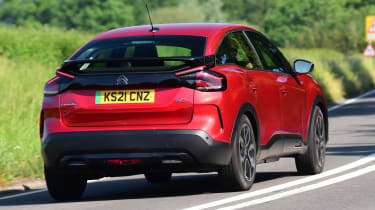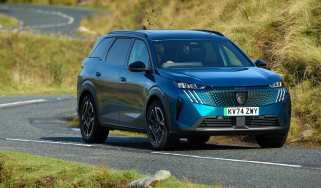Citroen e-C4 Sense Plus: Living with it
We put Citroen's electric family hatchback through its paces in the real world with a long-term test
| On fleet since: | May 2021 |
|---|---|
| List price new: | £30,895 after plug-in car grant |
| Options: | Premium metallic paint (£700) |
| Mileage to date: | 900 |
| Efficiency to date: | 3.1 miles/kWh |
| Problems? | None so far |
Report 1: Introducing our Citroen e-C4
While every mainstream car manufacturer is fully committed to the electric transition, different brands are going about it in different ways. While some focus on standalone electric models and new sub-brands, those in the Stellantis Group, which includes Citroen, are offering the same models with a choice of petrol, diesel, hybrid or electric power.
The C4 is a typical example of this – although it's notable that Citroen isn't offering it as a plug-in hybrid, as it believes current charging speeds and ranges are now sufficient for buyers of cars this size not to need the 'stepping stone' of a plug-in hybrid.
For the latest McIlroy family runabout, we've chosen the fully electric version, which Citroen dubs the e-C4. We reckon the vast majority of trips it'll undertake in this role will be well within the comfort zone of its claimed 217-mile range.
We went for the entry-level Sense Plus trim level, with the addition of eye-catching Elixir Red metallic paint for £700 as an optional extra. Picking the most basic version hasn't left us feeling hard done by when it comes to standard kit, though; LED lights, dual-zone climate control along, a 10-inch touchscreen infotainment system, a digital instrument panel and a head-up display are all standard. That comes to just under £31,000 bought outright, or around the £400 per month mark on a PCP finance deal.
Over the next six months, we'll be evaluating how the e-C4 performs both as an electric car and as practical family transport. So far, it has done everything right. We've been using it for all our routine short journeys, covering school runs, shopping trips and so on. We've been charging it every three or four days, at which point the battery is about half depleted.
Initial observations are of a comfortable ride around town on the car's hydraulic suspension, as well as plenty of space in the back and in the 380-litre boot for our son and his kit. On longer trips, it's evident that the predicted range drops quite rapidly at motorway speed, but we haven't felt true range anxiety at any point so far.





